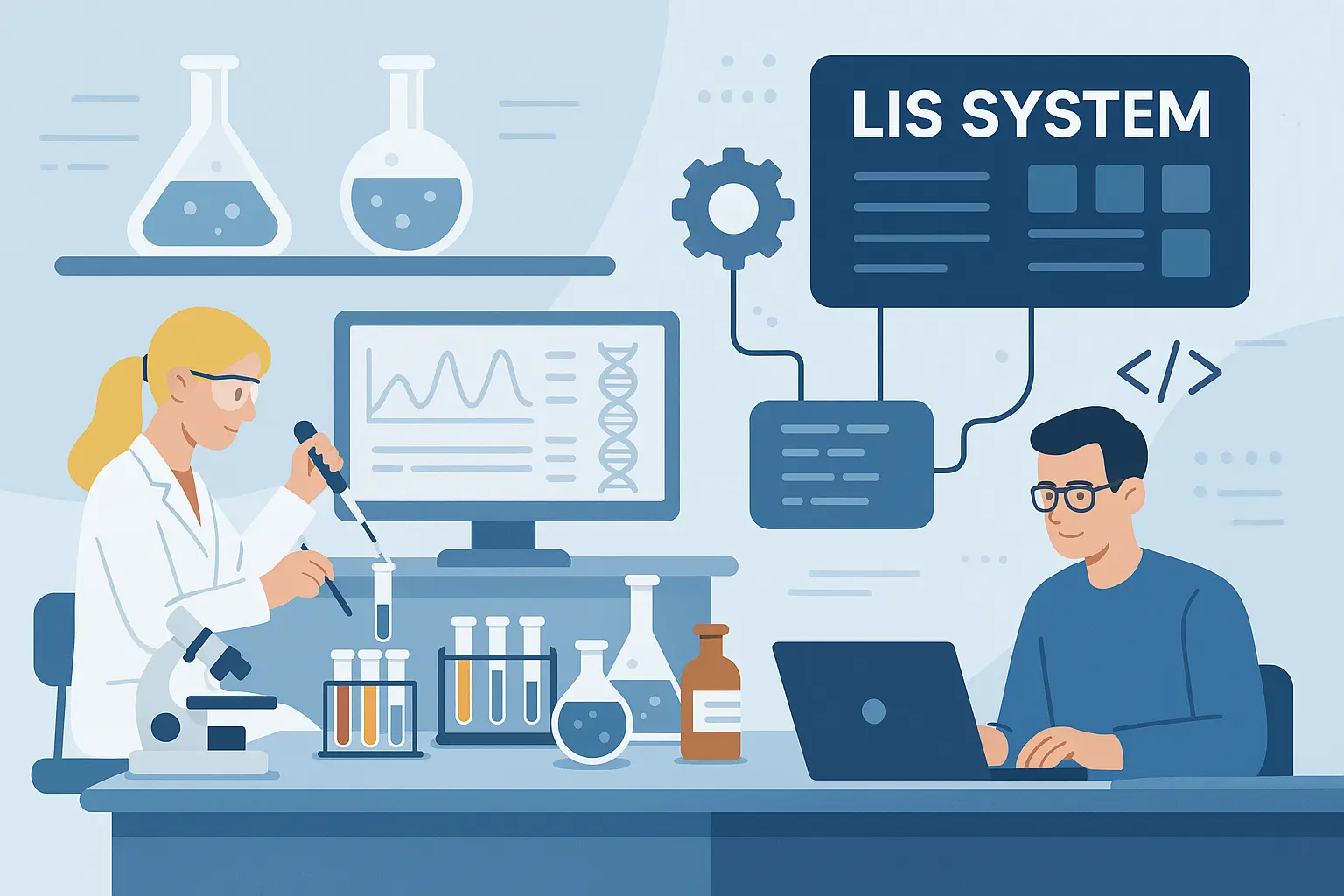Blog
Laboratory Information Management System Software: Advances in Clinical Lab Workflow
March 4, 2025
Laboratory workflow management in healthcare systems has expanded rapidly from relatively straightforward patient sample tracking processes with a pathology specimen tracking system to pathology lab software solutions supporting and automating laboratory data tracking, sample analysis, instrument integration, centralized data access, and storage.
It’s generally understood that a laboratory information system (LIS) provides the backbone for laboratory administrative, operational, and financial pathology lab management workflow in medical labs.
For those unaware of the latest advancements and what’s possible with modern LIS system software, we invite you to continue reading our detailed breakdown of advanced pathology LIS systems and their benefits.
Learn More: Can Your Laboratory Information System Support the Latest LIS System Technology?

Laboratory Information Systems - What Are They?
A lab information system (also known as a medical LIS and lab pathology software), by definition, is designed to handle data management for a laboratory at scale. The system helps minimize the stress of managing a lab by improving the efficiency of collecting, tracking, and analyzing test results in a clinical setting. The full scope of laboratory information system software extends beyond effectively managing sample tracking processes to include various other important lab workflows, such as:
- Automated barcoding of samples
- Avoidance of manual error and test-code mismatches
- Monitoring of data analytics and lab audits
- Maintenance of lab equipment/instruments
- Management of workload among lab personnel and inventory
- Integration of the laboratory information system and laboratory billing software for easier and more accurate lab revenue cycle management (lab RCM)
Pathology LIS Systems and Clinical Laboratory Management
In healthcare, pathology LIS systems integrate all processes that track a patient’s journey from test order to test result. From the moment a patient first encounters a hospital/clinic where an electronic health record (EHR) of the patient’s details are created, to when the final test report is generated, to when lab billing is completed, the LIS system interfaces with other laboratory software systems and analytical instruments to seamlessly exchange data, manage samples, automate workflows, and produce timely and accurate test results.
Hospitals and clinics handle large data streams and need the best laboratory information system software solutions to streamline and organize the data, thus enabling clinicians to draw clinical insights from a patient’s lab reports.
In addition to running a sample through the required tests in a lab, other laboratory information system functions such as ensuring compliance with government regulations, documentation, managing lab resources, and securing centralized data storage/access are integrated into a lab’s medical LIS for efficient pathology lab management.
Learn More: The Four Most Important Things to Consider When Modernizing a Laboratory
.webp)
The Best Laboratory Information System Software Benefits
The best laboratory information system software benefits lie in its ability to digitize and automate clinical lab processes, enabling efficient pathology lab management. An advanced LIS system enhances workflow efficiency, accuracy, and connectivity, transforming laboratory operations for optimal performance.
The advantages that come with an advanced medical LIS include:
- Swift registration and barcoding of samples
- Flexibility in LIS lab solutions to adopt new tests/updates into a sample lab workflow
- Assurance of compliance with government regulatory bodies, to ensure the lab’s tests/diagnostics and quality control are up-to-date
- Standardized test workflows to ensure accuracy
- Integrates with instruments in the lab to maintain a unified interface for deploying a diagnosis/workflow
- The LIS system supports data management and interoperability between multiple laboratory software systems to seamlessly integrate the lab with the clinic/hospital, etc.
- Maintains a searchable audit trail
- Assured quality control of sample management
Laboratory Information System Functions: How Do They Work?
A basic lab information system manages patient samples and all the types of data associated with those samples (consultation details such as demographics, medical history, diagnostic tests run, results from the test, lab billing, etc.).
A clinical laboratory management workflow can become complicated due to intersections of data among and within samples. Laboratory information systems streamline this process by sample tracking and recording a patient’s barcoded sample, loading/logging it into the appropriate lab workflow, and tracking its progress at every stage, as well as generating reports from the tests run and the recorded test results. A patient’s consolidated data can thus be accessed/retrieved by lab personnel through a database search or a patient’s demographic data housed within the lab information system.
Standard LIS system workflow can be summarized into the following steps: accessioning, recording, sample tracking, obtaining results, reporting, and storing/managing samples over time. These pathology LIS systems improve on previous manual record-keeping strategies and minimize inconsistencies when samples are labeled and stored through barcoding. This leads to enhanced sample identification and retrieval, when necessary, as well as turnaround times and ultimately, patient safety.
The best LIS software solutions can also interface with laboratory instruments, and a sample’s status can be instantly referenced by its barcode, and securely stored for long periods on an internal server/centralized database.
Case Study: Summit Pathology - Achieving Laboratory Profitability Amidst Operational Pressures

The Differences Between Laboratory Information Systems and Lab LIMS
It should be noted that laboratory information systems (LIS systems) and laboratory information management systems (LIMS) are terms often used interchangeably, even though they have been designed for separate lab environments.
LIS systems support patient-centric lab workflow in a medical capacity, whereas a lab LIMS refers to lab workflows that are sample-centric and in most cases not related to healthcare.
The best LIMS (LIMS lab management software) thus has a wider application and may be installed to ensure efficient sample handling in industrial, food/agricultural, and biomedical labs.
The best LIS software solutions prioritize patient data security and confidentiality, strictly adhering to regulatory standards like HIPAA to ensure compliance and privacy. Beyond data protection, a lab information system shares many core functions with lab LIMS solutions, including sample management and tracking, maintaining historical records, interfacing with laboratory instruments and software for seamless data exchange, and integrating lab analysis results into comprehensive reports.
Despite these similarities, LIMS providers build software that centers around samples (individually or in large batches) and must comply with standards or regulations that ensure good lab practices, such as ISO/IEC 17025.
As the best LIMS and best LIS software evolves, their functionalities will continue to overlap (LIS vs. LIMS). Because of this, laboratory information system vendors such as LigoLab must continue to make sure the differences are clear.
When selecting a laboratory information system, connect with LIS software vendors. They can provide in-depth demonstrations of their pathology software and offer expert guidance on how the medical LIS solution can be customized to meet the specific needs of your laboratory.
Learn More: Automation in Pathology Lab Management Using Advanced LIS System Software
The Importance of Laboratory Information Systems
In conclusion, pathology LIS systems support efficient integration of a lab’s workflows and the best laboratory information system companies - with laboratory input - can modify these systems, customizing them to each lab’s unique requirements. For example, an anatomic pathology LIS must facilitate a very different workflow than a molecular LIS.
Both minimize manual errors and improve lab productivity by recording and managing samples and patient data that would otherwise require interaction from lab personnel, thus improving the overall efficiency of a laboratory’s technical operations.
Regardless of which system you choose, the right LIS system backed by the right LIS company will create unique advantages that enable the lab to differentiate, a key factor in retaining clients and attracting new business. This flexibility will also ensure present and future success for the lab because it enables quick pivots to go after new opportunities as they present themselves.






